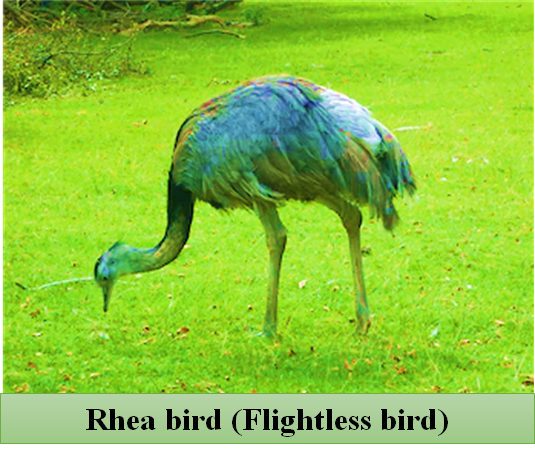
Flightless bird Rhea is found in:
(a) Australia
(b) South America
(c) North America
(d) Africa
Answer
515.1k+ views
1 likes
Hint: Flightless bird Rhea is large birds that are native to the continent where the Amazon rainforest possesses high biodiversity containing a major proportion of earth’s unique species of animals including Llama, anaconda, jaguar, Rhea, etc. Brazil is the largest country of this continent and it is the home to the world’s highest uninterrupted waterfall, Angel Falls in Venezuela, the largest river by volume, the Amazon river, and many more.
Complete answer:
The Rheas are large flightless birds native to South America. The IUCN currently rates the American Rhea as Threatened in their native ranges. Rheas are limited within the continent to Argentina, Brazil, Peru, Bolivia, Chile, Uruguay, and Paraguay. They are grassland birds and prefer open lands.
Additional Information:
- Rheas are large with grey-brown plumage, long legs, and long necks similar to an ostrich.
- The name “Rhea” comes from the Greek Titan Rhea, whose name is thought to come from “ground”.
-A large male of Rhea americana can reach up to 67in. tall at the head, 39in. at the back and can even weigh up to 40kgs.
-The wings are large and they spread it while running.
-Unlike most of the birds, this flightless bird has only three toes.
-The urine is stored separately in an expansion of the cloaca.
-The greater Rheas prefer to breed near water and prefer low lands whereas the lesser Rheas can inhibit most shrubland, grassland, and even desserts.
So, the correct answer is, ‘South America’.
Note: -Rheas are distinctly related to ostrich and emu.
-They are recognized as two extant species: the greater or American Rhea (Rhea americana) and the lesser or Darwin’s Rhea (Rhea pennata). There is another species Puna Rhea (Rhea tarapacensis) which is listed as a separate species by IUCN.
-A small population of Rhea has also emerged in north-eastern Germany.

Complete answer:
The Rheas are large flightless birds native to South America. The IUCN currently rates the American Rhea as Threatened in their native ranges. Rheas are limited within the continent to Argentina, Brazil, Peru, Bolivia, Chile, Uruguay, and Paraguay. They are grassland birds and prefer open lands.
Additional Information:
- Rheas are large with grey-brown plumage, long legs, and long necks similar to an ostrich.
- The name “Rhea” comes from the Greek Titan Rhea, whose name is thought to come from “ground”.
-A large male of Rhea americana can reach up to 67in. tall at the head, 39in. at the back and can even weigh up to 40kgs.
-The wings are large and they spread it while running.
-Unlike most of the birds, this flightless bird has only three toes.
-The urine is stored separately in an expansion of the cloaca.
-The greater Rheas prefer to breed near water and prefer low lands whereas the lesser Rheas can inhibit most shrubland, grassland, and even desserts.
So, the correct answer is, ‘South America’.
Note: -Rheas are distinctly related to ostrich and emu.
-They are recognized as two extant species: the greater or American Rhea (Rhea americana) and the lesser or Darwin’s Rhea (Rhea pennata). There is another species Puna Rhea (Rhea tarapacensis) which is listed as a separate species by IUCN.
-A small population of Rhea has also emerged in north-eastern Germany.

Latest Vedantu courses for you
Grade 11 Science PCM | CBSE | SCHOOL | English
CBSE (2025-26)
School Full course for CBSE students
₹41,848 per year
Recently Updated Pages
Master Class 11 Business Studies: Engaging Questions & Answers for Success

Master Class 11 Economics: Engaging Questions & Answers for Success

Master Class 11 Accountancy: Engaging Questions & Answers for Success

Master Class 11 Computer Science: Engaging Questions & Answers for Success

Master Class 11 English: Engaging Questions & Answers for Success

Master Class 11 Maths: Engaging Questions & Answers for Success

Trending doubts
Which one is a true fish A Jellyfish B Starfish C Dogfish class 11 biology CBSE

Difference Between Prokaryotic Cells and Eukaryotic Cells

1 ton equals to A 100 kg B 1000 kg C 10 kg D 10000 class 11 physics CBSE

One Metric ton is equal to kg A 10000 B 1000 C 100 class 11 physics CBSE

How much is 23 kg in pounds class 11 chemistry CBSE

Net gain of ATP in glycolysis a 6 b 2 c 4 d 8 class 11 biology CBSE




